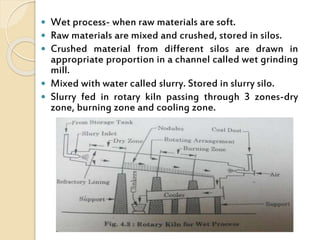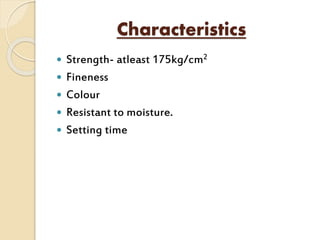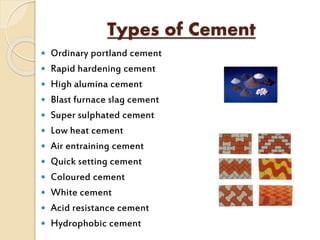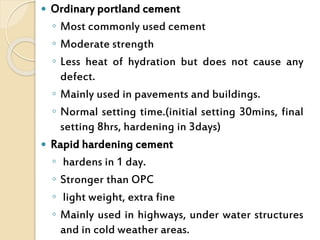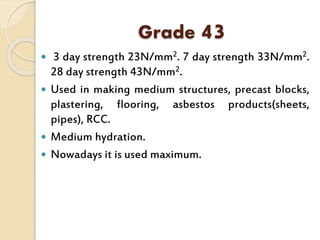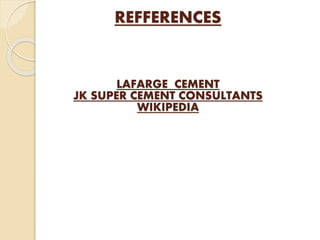Cement
- 2. Table of Contents Introduction Raw materials of cement Manufacturing of cement Characteristics of cement Types of cement and their Properties Grades of cement Function of cement ◦ Setting ◦ Ratio of mixture Storage of cement Tests Uses of cement Conclusion
- 3. Introduction Cement is a building material for binding bricks, stones or aggregates. Used for making mortar or concrete. Cements natural and artificial. Natural cement-burning and crushing of stones and lime. Artificial cement-burning at high temperature and gypsum is added.
- 4. Lime- excess will decrease the strength. Deficiency will make it set quickly. Silica- higher silica increases the strength but setting time is prolonged. Alumina- results in quick setting. Excess alumina weakens cement. Iron oxide- for hardness and strength. Magnesia- hardness and colour.
- 5. Raw material ingredient range approximate lime 60-65% 63 Silica 17-25% 21 Alumina 4-8% 6 Iron oxide 1-6% 3 Magnesia 1-3% 1.5 Calcium sulphate 3-5% 4 Sulphur 1-3% 1 Alkalies 0.2-1% 0.5
- 6. Manufacturing Of Cement Mixing of raw material(wet or dry) Burning Grinding
- 7. Wet process- when raw materials are soft. Raw materials are mixed and crushed, stored in silos. Crushed material from different silos are drawn in appropriate proportion in a channel called wet grinding mill. Mixed with water called slurry. Stored in slurry silo. Slurry fed in rotary kiln passing through 3 zones-dry zone, burning zone and cooling zone.
- 8. Grinding- cooled clinkers are ground and gypsum is added. As cement comes out of grinding mill it is collected in hopper for storage in silos. c li n k e r
- 9. Dry process-available raw material is hard. Mixing of raw materials undergo crushing, drying, reduction in size, mixing in correct proportion.
- 11. KILN
- 12. THE CEMENT MANUFACTURING PROCESS 1. BLASTING : The raw materials that are used to manufacture cement (mainly limestone and clay) are blasted from the quarry. Quarry face 1. BLASTING 2. TRANSPORT 3. CRUSHING AND TRANSPORTATION : The raw materials, after crushing, are transported to the plant by conveyor. The plant stores the materials before they are homogenized. quarry 3. CRUSHING & TRANSPORTATION 2. TRANSPORT : The raw materials are loaded into a dumper. crushing conveyor dumper storage at the plant loader
- 13. 1. RAW GRINDING : The raw materials are very finely ground in order to produce the raw mix. 1. RAW GRINDING Raw grinding and burning 2. BURNING 2. BURNING : The raw mix is preheated before it goes into the kiln, which is heated by a flame that can be as hot as 2000 °C. The raw mix burns at 1500 °C producing clinker which, when it leaves the kiln, is rapidly cooled with air fans. So, the raw mix is burnt to produce clinker : the basic material needed to make cement. conveyor Raw mix kiln cooling preheating clinker storage at the plant Raw mill
- 14. THE CEMENT MANUFACTURING PROCESS 1.GRINDING : The clinker and the gypsum are very finely ground giving a “pure cement”. Other secondary additives and cementitious materials can also be added to make a blended cement. 1. GRINDING Grinding, storage, packing, dispatch 2. STORAGE, PACKING, DISPATCH 2. STORAGE, PACKING, DISPATCH :The cement is stored in silos before being dispatched either in bulk or in bags to its final destination. clinker storage Gypsum and the secondary additives are added to the clinker. silos dispatch bags Finish grinding
- 15. Characteristics Strength- atleast 175kg/cm2 Fineness Colour Resistant to moisture. Setting time
- 16. Types of Cement Ordinary portland cement Rapid hardening cement High alumina cement Blast furnace slag cement Super sulphated cement Low heat cement Air entraining cement Quick setting cement Coloured cement White cement Acid resistance cement Hydrophobic cement
- 17. Ordinary portland cement ◦ Most commonly used cement ◦ Moderate strength ◦ Less heat of hydration but does not cause any defect. ◦ Mainly used in pavements and buildings. ◦ Normal setting time.(initial setting 30mins, final setting 8hrs, hardening in 3days) Rapid hardening cement ◦ hardens in 1 day. ◦ Stronger than OPC ◦ light weight, extra fine ◦ Mainly used in highways, under water structures and in cold weather areas.
- 18. High alumina cement ◦ Long setting time(initial setting time 3-5hrs) ◦ Very high compressive strength ◦ High resistance to sulphate ◦ Used in sea water construction. ◦ High heat of hydration ◦ Highly resistant to corrosion and temp. ◦ Very expensive, unsuitable for massive construction. ◦ Extra care required.
- 19. Blast furnace slag cement ◦ Low heat of hydration ◦ Not suitable for dry acid zones ◦ Less strength than other cement, need longer curing period. ◦ cheap Quick setting cement ◦ Higher aluminium sulphate content. ◦ Sets in 5mins and final setting 30mins. ◦ Extra care required, hardens very quickly ◦ Used in running water
- 20. Coloured cement ◦ Can get colours by adding mineral pigments. ◦ Green(chromium oxide), blue(cobalt), red, brown, yellow(iron oxides) ◦ Used for decorations.
- 21. White cement ◦ Raw material- pure white chalk(lime stone) ◦ Free from iron oxide and manganese oxide. ◦ Dries quickly. ◦ Used for plastering or ornamental flooring or marking.
- 22. Grades of Cement Before 1987 only one grade of cement. After 1987 higher grades were introduced. Grades signifies the strength of cement after 28 days. Grade 33- attains 33N/mm2 in 28days, when the mortar of cement and sand is 1:3. initial setting time 30mins and final setting time maximum 10hrs. Grade 43- attains 43N/mm2 in 28 days Grade 53- attains 53N/mm2 in 28 days.
- 23. Grade 53 3 day strength 27 N/mm2. 7 day strength 37 N/mm2. 28 day strength 53N/mm2. Used in making strong structures-bridges, highways, high rise buildings, concrete roads, precast pavement blocks and tile blocks. Fast hydration, high heat generation. Hence requires more care.
- 24. Grade 43 3 day strength 23N/mm2. 7 day strength 33N/mm2. 28 day strength 43N/mm2. Used in making medium structures, precast blocks, plastering, flooring, asbestos products(sheets, pipes), RCC. Medium hydration. Nowadays it is used maximum.
- 25. Grade 33 3 day strength 16N/mm2. 7 day strength 22N/mm2. 28 day strength 33N/mm2. Used in making general construction work, mass concrete, plain plastering, precast blocks, plastering, flooring. Nowadays it is used less with more availability of grade 43.
- 26. Setting of Cement Setting-when water is mixed with cement, the action of changing from flux to solid state. During the next stage of hydration, paste gains strength and starts hardening. Initial setting time period- is the time required when the cement paste looses its plasticity. For OPC- 30mins Final setting time period- is the time required to achieve hardness. For OPC – 10hrs
- 27. Storage Guidelines Away from moisture. Storage period should be short. If long, should be stored in steel drums Avoid jute bags More frequent delivery of smaller lots Damp proof sheds Bags should be stacked in piles. Not more than 10bags in a pile. Cover with tarpaulin Ensure FIFO.
- 28. Tests For fineness ◦ Sieve test ◦ Surface area test For normal consistency – to determine the setting time For soundness
- 29. Application of Cement Cement as mortar ◦ For laying or binding masonry units (bricks , stones ,etc) ◦ For pointing the masonry joints ◦ For plastering the surface to protect from weather. ◦ For decorative finish ◦ For filler material in ferro cement construction. ◦ For damp proof course below the ground level. ◦ Water proofing, crack repairs and structures.
- 30. Cement as concrete ◦ For manufacturing solid and hollow concrete blocks. ◦ For laying subfloors and floors ◦ For RCC constructions (slab, beam, column, stairs, footings, etc)
- 31. CEMENT A CATEGORY ULTRATECH CEMENT ACC CEMENT SHREERAM CEMENT LAFARGE CEMENT B CATEGOREY J.K SUPER CEMENT J.P CEMENT BIRLA UTTAM FREE CEMENT C CATEGORY BIRLA CHETAK ROCK STRONG CEMENT BINANI CIMENT RS.28 0 RS.30 0 RS.26 5 RS.28 0 RS.26 0-255 RS.27 0 CATEGORIES AND PRICES OF CEMENT
- 32. TYPES OF CEMENT GREY CEMENT P.P.C (PORTLAND PAZZOLANA CEMENT) O.P.C (ORDINARY PAZZOLANACEMENT) GRADE 43 GRADE 53 GRADE 33 WHITE CEMENT IT HAS MORE AMMOUNT OF GYPSUM IRON OXIDE IS 1% USED ONLY FOR DECORATIVE WORK FLAG CEMENT MASONARY CEMENT TYPES OF CEMENT
- 34. REFFERENCES LAFARGE CEMENT JK SUPER CEMENT CONSULTANTS WIKIPEDIA
- 35. THANK YOU
- 36. FINENESS So we need to determine the fineness of cement by dry sieving as per IS: 4031 (Part 1) – 1996.The principle of this is that we determine the proportion of cement whose grain size is larger then specified mesh size. The apparatus used are 90µm IS Sieve, Balance capable of weighing 10g to the nearest 10mg, A nylon or pure bristle brush, preferably with 25 to 40mm, bristle, for cleaning the sieve. Sieve shown in pic below is not the actual 90µm seive.Its just for reference. Procedure to determine fineness of cement i) Weigh approximately 10g of cement to the nearest 0.01g and place it on the sieve. ii) Agitate the sieve by swirling, planetary and linear movements, until no more fine material passes through it. iii) Weigh the residue and express its mass as a percentage R1,of the quantity first placed on the sieve to the nearest 0.1 percent. iv) Gently brush all the fine material off the base of the sieve. v) Repeat the whole procedure using a fresh 10g sample to obtain R2. Then calculate R as the mean of R1 and R2 as a percentage, expressed to the nearest 0.1 percent. When the results differ by more than 1 percent absolute, carry out a third sieving and calculate the mean of the three values. Reporting of Results Report the value of R, to the nearest 0.1 percent, as the residue on the 90µm sieve.






